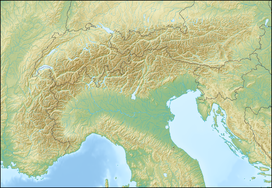|
Splügen Pass
The Splügen Pass (German: Splügenpass; Italian: Passo dello Spluga; Romansh: Pass dal Spleia 2,114 m (6,936 ft)) is an Alpine mountain pass of the Lepontine Alps. It connects the Swiss, Grisonian Splügen 5 kilometres (3.1 mi) to the north 675 metres (2,215 ft) below the pass with the Italian Chiavenna 21 kilometres (13 mi) to the south at the end of the Valle San Giacomo 1,789 metres (5,869 ft) below the pass. GeographyThe pass road connects the Swiss Hinterrhein valley and Splügen in the canton of Graubünden with the Valle San Giacomo and Chiavenna in the Italian province of Sondrio, the road continuing to Lake Como. The pass is the water divide between the drainage basins of the Rhine, which flows into the North Sea, and the Po, which flows into the Adriatic. The pass is overlooked by Pizzo Tambo and the Surettahorn, on its western and eastern side, respectively. On the Italian side of the pass is Montespluga, a small three street village that is cut off from both Italy and Switzerland during the winter.  Since the opening of the San Bernardino road tunnel in 1967, the pass has lost its former importance; it is not kept open in winter. Thanks to its lack of importance, it is now a quiet pass where essential portions of the historical roads have survived allowing a good historical review for hikers on the Via Spluga.[2] HistoryThe pass was in use in the Roman era. It possibly corresponds to Cunus Aureus shown on the Tabula Peutingeriana (which may alternatively have referred to the Julier Pass). The name Splügen itself is possibly derived from specula ("lookout"). In the Middle Ages, the bishops of Chur had the trade route relocated to Septimer Pass. From 1818 to 1823 the modern road was built at the behest of the Austrian authorities, then ruling the Kingdom of Lombardy–Venetia in the south. In 1840, author Mary Shelley traveled through the pass on the way to Lake Como with her son. She describes the pass in her travel narrative, Rambles in Germany and Italy, published in 1844: 
In 1843 the road was further expanded with a 312 m (1,024 ft) long avalanche gallery designed by the Swiss engineer Richard La Nicca which today is out of use but largely preserved. Plans to build a railroad line across Splügen Pass were abandoned in favour of the Gotthard railway line, which opened in 1882. The Pass is also mentioned in Arthur Conan Doyle's The Adventure of the Illustrious Client, a Sherlock Holmes short story of 1924. The Austrian Baron Adalbert Grüner, the villain of the story, murdered his wife by throwing her from the Pass, although Holmes cannot prove it. See alsoBibliography
References
External linksWikimedia Commons has media related to Splügen Pass.
|
||||||||||||||||||||
Portal di Ensiklopedia Dunia

